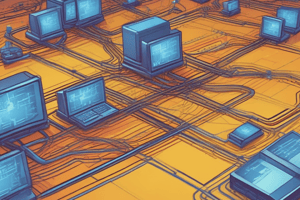Podcast
Questions and Answers
What is the main reason behind Linux's use of an interface naming convention?
What is the main reason behind Linux's use of an interface naming convention?
- To make it easy to identify the interface type
- To clarify which specific ethernet port matches with the interface name (correct)
- To make it compatible with other operating systems
- To avoid naming conflicts between devices
What is the prefix used to signify an Ethernet interface in the systemd naming scheme?
What is the prefix used to signify an Ethernet interface in the systemd naming scheme?
- sl
- ib
- en (correct)
- wl
What is the highest priority rule used by the operating system to name and number the network interfaces?
What is the highest priority rule used by the operating system to name and number the network interfaces?
- Naming the interface after the index provided by the BIOS or firmware (correct)
- Naming the interface after the PCI express slot index
- Naming the interface after the interface's address at the corresponding bus
- Naming the interface after its MAC address
What is the main difference between the old and new naming conventions for network interfaces in Linux?
What is the main difference between the old and new naming conventions for network interfaces in Linux?
What is the last resort rule used by the operating system to name and number the network interfaces?
What is the last resort rule used by the operating system to name and number the network interfaces?
Flashcards are hidden until you start studying
Study Notes
Network Interface Naming
- The network interface enp3s5 was named based on its address in the corresponding bus and slot.
- The device address 03:05.0 reveals the associated device, a Realtek Semiconductor Co., Ltd. RTL-8110SC/8169SC Gigabit Ethernet (rev 10) controller.
Network Interface Management
- Network interfaces are created by the Linux kernel, but there are many commands to interact with them.
- The ifconfig command is deprecated and has been superseded by the ip command, which can manage many aspects of TCP/IP interfaces, including routes and tunnels.
- The ip command can be overkill for most ordinary tasks, so auxiliary commands like ifup and ifdown are used to configure network interfaces based on interface definitions found in the file /etc/network/interfaces.
Interface Configuration
- The /etc/network/interfaces file is used to configure network interfaces during system boot.
- Lines beginning with the word "auto" in the file are used to identify the physical interfaces to be brought up when ifup is executed with the -a option.
- Linux systems rely on configurations stored in plain text files under the /etc directory to bring up network connectivity during boot time.
Network Interface
- A network interface is the term used to refer to the communication channel configured to work with the network hardware attached to the system, such as an Ethernet or Wi-Fi device.
- The exception to this is the loopback interface, which is used by the operating system to establish a connection with itself.
- The main purpose of a network interface is to provide a route through which local data can be sent and remote data can be received.
Interface Naming Convention
- Older Linux distributions used a naming convention of eth0, eth1, etc. for Ethernet interfaces, and wlan0, wlan1, etc. for wireless interfaces.
- This naming convention did not clarify which specific Ethernet port matches with the interface eth0, for example.
- Modern Linux systems use a predictable naming convention for network interfaces, making it easier to identify which interface corresponds to which device and port.
- The naming convention uses a two-character prefix to signify the interface type, such as "en" for Ethernet, "wl" for Wireless LAN, and "ww" for Wireless WAN.
Prioritizing Interface Naming Rules
- The operating system uses the following rules to name and number network interfaces, in order of priority:
- Name the interface after the index provided by the BIOS or firmware.
- Name the interface after the PCI express slot index.
- Name the interface after its address at the corresponding bus.
- Name the interface after the interface's MAC address.
- Name the interface using the legacy convention.
Studying That Suits You
Use AI to generate personalized quizzes and flashcards to suit your learning preferences.




